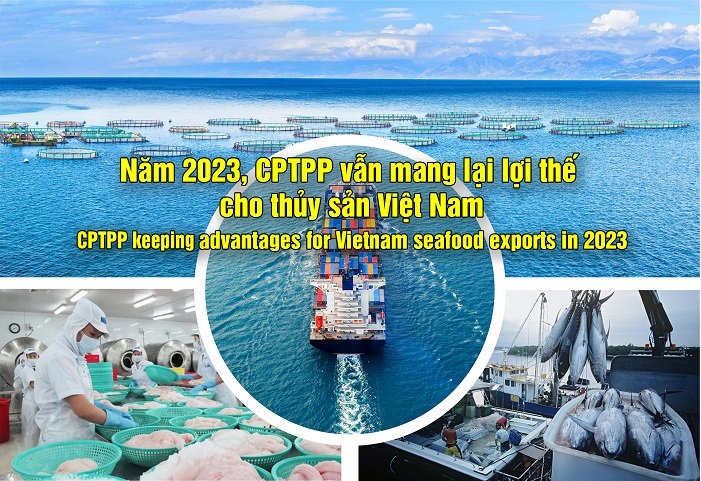(seafood.vasep.com.vn) Vietnam's seafood export turnover in the second quarter of 2023 reached over 2.3 billion USD, 30% higher than the first quarter. However, compared to the same period in 2022, the negative growth rate of 27.5% remained unchanged from the first quarter. Therefore, by the end of the first half of this year, seafood exports were 27.5% lower than the same period last year, reaching 4.15 billion USD. While exports to most markets such as the US and EU decreased significantly (down 46% and 33% respectively), exports to the CPTPP bloc still had more positive results.
In Q2 2023, seafood exports to the US and China showed significant improvement. The export value to both markets was much higher than in Q1. Specifically, exports to the US increased by 49%, and to China by 57%. Compared to the same period last year, the negative growth of these two markets was also lower than in Q1.
However, exports to Japan, Korea, and the EU only saw modest increases compared to Q1, and even decreased further when compared to the same period last year.
Inventory in the US and China is gradually clearing, leading to increased import demand. While the impact is not yet significant, there are positive signals. However, inflation continues to restrain consumer spending in other countries, resulting in no signs of export breakthrough in Japan, Korea, EU, and other important markets.

While exports to most markets such as the US and EU decreased significantly (down 46% and 33% respectively), exports to the CPTPP bloc still had more positive results.
Exports to CPTPP market: less competitive pressure
In the first half of 2023, Vietnam's seafood exports to CPTPP countries reached 1.12 billion USD, down 22%. Following the general decline trend, exports to this market are also negatively affected. However, compared to other major markets such as the US and EU (down 46% and 33% respectively), the CPTPP bloc still has better results.
Despite a general decline in exports to Japan, Vietnam managed to limit the decrease to a modest 11%. This positive outcome can be attributed to Vietnam's value-added products maintaining their advantages and the increasing trend of importing seafood materials from Japan to Vietnam for re-processing and export. Additionally, Chile is the only country in the bloc that experienced a positive growth rate of 15% during the first 6 months of this year.
Lack of raw materials, increased input costs, many businesses focus on producing value-added goods and take advantage of import tax incentives under the CPTPP to stabilize jobs for workers and to take advantage of processing capacity, creating more income by exporting to Japan as well as other countries in the CPTPP.
The context of many unfavorable factors in recent years is causing Vietnam to gradually lose its position in major markets such as the US and China to other suppliers with advantage in supply and low production costs such as Ecuador, India, Indonesia, etc. Typically, shrimp products - a strategic product of Vietnam's seafood industry, are increasingly losing market share in the US and China when these markets are flooded with cheap shrimp from Ecuador and India.
Meanwhile, thanks to the advantage of import tax, the strength of deep processing, processing of value added goods and geographical position, Vietnamese seafood products still hold the leading position in many markets in the CPTPP bloc.

Vietnamese shrimp holds the No. 1 position in Japan, accounting for 25-26% of the market share
For example, for shrimp, Vietnam has the No. 1 position in Japan, accounting for 25-26% of the market share. Most impressively, the Australian market has made a breakthrough in importing Vietnamese shrimp after 5 years, helping Vietnam's market share to increase from 32% to 69%.
After 5 years, the import tax on most Vietnamese seafood products to CPTPP countries has been reduced to 0% or already enjoyed the tax rate of 0%. With this competitive advantage, Vietnamese enterprises are holding the number one position in some markets and increasing market share in other markets.
The CPTPP bloc accounts for 15.5% of the world's seafood import value with an import turnover of 21-27 billion USD/year. In 2022, excluding Vietnam, the total seafood import turnover of 10 countries in the bloc is 25 billion USD. Vietnam is the third largest seafood supplier to CPTPP countries, after China and the US.There is still a lot of room in the CPTPP market for Vietnamese seafood. However, it is important that we have a stable source of raw materials in the country, as well as diversify the supply of imports from intra-regional countries. The seafood business community eagerly anticipates the invaluable support of ministries and sectors, particularly in securing capital solutions for production and export. With the right conditions and effective partnerships, we are confident in maintaining Vietnam's prominent position in the global seafood arena through leveraging the CPTPP and other FTAs.
Compiled by Thuy Linh